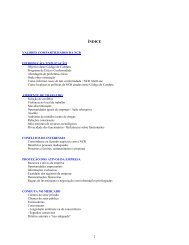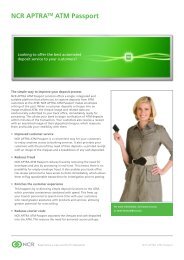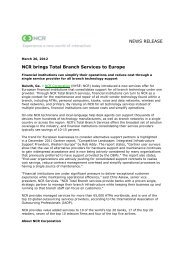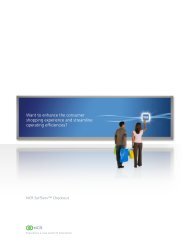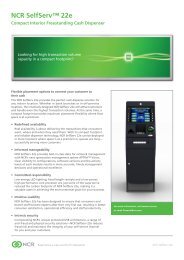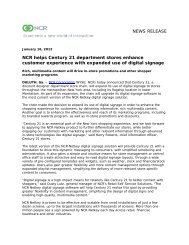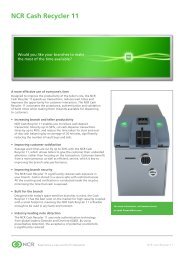Financial Inclusion White Paper - NCR
Financial Inclusion White Paper - NCR
Financial Inclusion White Paper - NCR
You also want an ePaper? Increase the reach of your titles
YUMPU automatically turns print PDFs into web optimized ePapers that Google loves.
used at any ATM location to avail financial services. Interoperability provides<br />
flexibility to transact and secures cash. These facilities are currently not<br />
available for the financially underserved population but there is a need for<br />
these services for this set.<br />
There are different variations of ATMs:<br />
Cash Dispensers and Cash Deposit Machines (CDM)<br />
These would typically do routine transactions such as cash dispensation or<br />
deposits and statement printing<br />
Multi-function ATM<br />
These ATMs typically handle other transactions such as check deposit, bill<br />
payments and travel ticket bookings, etc, beyond the routine cash and dash<br />
like the CDM<br />
2. Mobile Phone Applications<br />
The explosion in mobile telephony has revolutionized the way individuals<br />
communicate with each other and with businesses. By the end of 2009, more<br />
than 60 percent of the global population will have a mobile phone subscription,<br />
representing global growth of eight percent. Across Europe and Russia, there<br />
is already more than one mobile phone for every man, woman and child.<br />
[Source: Economist Intelligence Unit].<br />
Of all the telephone connections in India, 90 percent are mobile 9 . The demand<br />
for Mobile phones is expected to rise by 24 percent in 2009, far outstripping<br />
global growth rates.<br />
In many markets, financial institutions are offering banking services via<br />
mobile phones, each with varying levels of functionality, ease-of-use, cost and<br />
mass acceptance.<br />
In western economies, phone banking is offered to established customers as a<br />
means of convenience, eliminating the need for the customer to visit the bank<br />
and perform transactions ‘on the go’.<br />
Because of the penetration in poor<br />
and developing economies, mobile<br />
phones are regarded as a tool to<br />
deliver financial services to the<br />
masses.<br />
The biggest disadvantage with<br />
mobile banking is the element of<br />
cash. When cash is needed, mobile<br />
banking requires the assistance of<br />
other technologies or channels.<br />
9 Source: Telecom Regulatory Authority of India (TRAI)<br />
27




